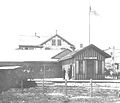- Mauch Chunk Switchback Railway
-
Mauch Chunk Switchback Railway
 Looking down at the Lehigh Canal landing, circa 1870.
Looking down at the Lehigh Canal landing, circa 1870.Location: Carbon County, Pennsylvania Coordinates: 40°51′3″N 75°48′17″W / 40.85083°N 75.80472°WCoordinates: 40°51′3″N 75°48′17″W / 40.85083°N 75.80472°W Built: 1827 Architect: Josiah White NRHP Reference#: 76001616 Added to NRHP: 1976 The Mauch Chunk Switchback Railway, earlier known as the Mauch Chunk Railroad and Mauch Chunk, Summit Hill and Switchback Railroad, was a 9-mile (14-km) gravity railroad in Pennsylvania that went between Mauch Chunk, now Jim Thorpe, and Summit Hill. After abandoning freight operations, the railroad survived until 1938 as an early roller coaster.
History
The Mauch Chunk Rail Road was built and owned by the Lehigh Coal and 69 Navigation Companys. Construction began in January 1827 on an existing road and the road opened on May 5, 1827.[1] It sent anthracite from company mines up at Summit Hill to the company's coal chutes in Mauch Chunk on the Lehigh River. The return trip was handled by mules,[2] who then rode the trains downhill.[3] Thus, downhill cars covered the trip in just half an hour, while the uphill trip took four hours.[2] The trains were sometimes up to fourteen cars long, hauling 25 short tons (23,000 kg) of anthracite.[3] The railroad was only the second in the United States (and the first coal road),[4] and it was scenic and exciting to ride downhill, so it became a tourist attraction, and started occasionally carrying passengers.[2][3] Soon, coal would only be handled in the morning, with passenger service taking over the afternoon. This recreational use would gain importance, become the sole purpose of the railroad, and inspire the development of the roller coaster.[3] Some famous personalities who visited the railroad over the years include Prince Maximilian of Wied, President Ulysses S. Grant, William Astor (son of John Jacob Astor), and Thomas Edison.[5]
In 1846, the railroad responded to increasing demand for coal[3] and the poor logistics of a single-track route by building a new up track consisting of two steam-powered, 120 horsepower (89 kW) funicular systems to replace the use of mules.[2] One of the inclines rose 664 feet (202 m) up Mount Pisgah,[3] and the other crossed Mount Jefferson. The downhill trip continued to be powered by gravity, as did the downhill portions of the otherwise uphill direction.[6] The up track was uniquely equipped with a ratchet which would prevent a car that detached from the cable from running away down the hill.[2] This invention would later evolve into the anti-rollback device used on roller coasters.[3] This was also when the railroad extended its name to the Mauch Chunk, Summit Hill and Switchback Railroad.[2] The modernization of the railroad reduced a passenger round-trip from 4.5 hours to just 80 minutes.[3]
In 1872, the Panther Creek Railroad opened as a replacement for the switchback line. The Central Railroad of New Jersey (CNJ) purchased it in 1874 and leased it to brothers Theodore and H. L. Mumford who operated the line as a tourist attraction. On May 24, 1929, the CNJ sold the line to the new Mauch Chunk Switchback Railway Company, which operated a few more years until 1932, at which point the line fell victim to the Great Depression. The mortgage on the property foreclosed and it was sold to scrapper Isaac Weiner for $18,000 (equal to $289,496 today).[2]
The right-of-way is now the Switchback Railroad Trail,[7] but efforts are underway to rebuild the Mt. Pisgah incline portion of the route.[4]
Gallery
References
- ^ "History of the Switch Back Gravity Railroad". http://www.switchbackgravityrr.org/sbhist.htm. Retrieved February 9, 2008.
- ^ a b c d e f g "CNJ Mauch Chunk Switchback". http://www.gingerb.com/cnj_mauch_chunk_switchback.htm. Retrieved February 9, 2008.
- ^ a b c d e f g h Pescovitz, David. "History: 1870". Inventing the Scream Machine. Encyclopædia Britannica, Inc.. http://www.britannica.com/coasters/1870.html. Retrieved February 9, 2008.
- ^ a b "Switch Back Home Page". http://www.switchbackgravityrr.org/. Retrieved February 9, 2008.
- ^ Vince Hydro's Insider's Guide to the Switchback, Jim Thorpe Insider's Press, 1999.
- ^ "The Mauch Chunk, Summit Hill, and Switchback Gravity Railroad". http://www.angelfire.com/pa5/switchbackrr/. Retrieved February 9, 2008.
- ^ "Mountain Bike Trails in Pennsylvania : Pocono Mountains Region Mountain Biking : Switchback Trail : bikekinetix.com". http://www.bikekinetix.com/t_pa/pa_rail/switchback_rt.php. Retrieved February 9, 2008.
Categories:- Buildings and structures on the National Register of Historic Places in Pennsylvania
- Railway-related listings on the National Register of Historic Places
- Funicular railways of the United States
- Defunct Pennsylvania railroads
- Railway lines opened in 1827
- Transportation in Carbon County, Pennsylvania
- 3ft 6in gauge railways
Wikimedia Foundation. 2010.








